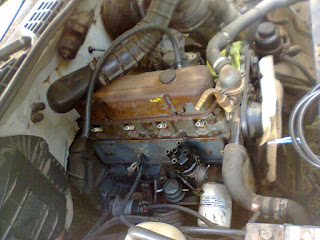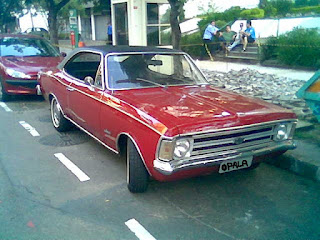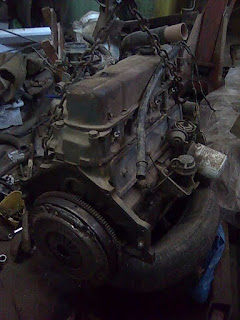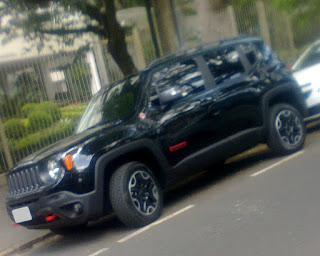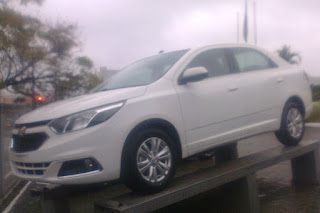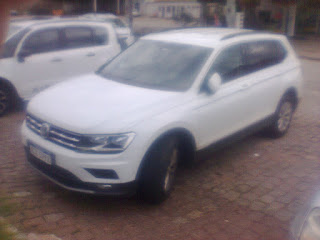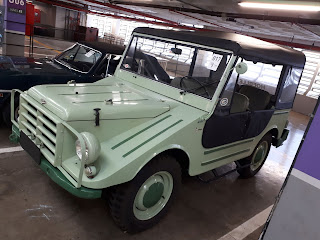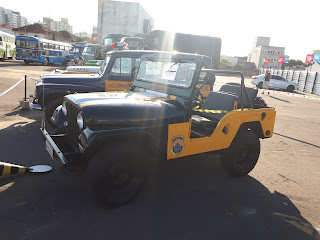This isi not the first street-legal sand-rail buggy I see in Florianópolis, Brazil, but it's unusual for being 4-wheel drive with solid axles. Fitted with a Volkswagen EA827 engine mounted at the rear position, just like the ones inspired by the Volkswagen Beetle mechanical layout, but I couldn't get the chance to figure out its transmission setup.
Tuesday, December 25, 2018
Sunday, December 16, 2018
Hadn't it been for displacement-based taxation in some countries, would the Chevrolet 153 or the Pontiac Iron Duke remain up-to-date?
Among spark-ignited engines, the Chevrolet 153 is still one of my favorites. Mostly known in my homeland Brazil for its 2.5L version used in the Opala, plus a very limited availability as a supposedly fuel-saver alternative to the 3rd-gen straight-6 in the light-duty versions of the full-size truck range, it's still praised by its outstanding reliability and ease of maintenance. The gear-driven valvetrain is a feature I still enjoy in this engine, much like the Volkswagen's boxer, even though the OHV layout is often pointed out as a downside when compared to modern designs with overhead camshaft(s).
With cast-iron block and head, the Chevrolet 153 was a cheap-to-build engine, becoming a mainstay for GM's former South African branch (and later its licensee Delta Motor Corporation when GM was forced to divest from South Africa during the Apartheid) also in smaller displacements at least until the late-80s. The smallest version however was the 1.8L one made in Argentina, where it was fitted to the local Opel K-180 derivative of the T-Platform, instead of the Isuzu G-series fitted to its Brazilian Chevrolet Chevette counterpart initially in 1.4L version (which everywhere else was OHV) to be subsequently increased to 1.6L and a later 1.0L version meant to take benefit of lower taxes which took effect in Brazil in the early '90s. Even though the Isuzu G-series had OHV versions in other markets, all the ones made in Brazil were OHC, which might not be an issue at all.
At least until '99, the rated power of the engine was also considered for tax purposes in Brazil, with earlier versions of the Opel Astra B sedan fitted with the 1.8L Family 2 engine detuned to 99PS until the displacement became the most important parameter for that matter. Since then, most cars with engines bigger than 2.0L are liable to higher taxes, which has led to some weird situations when certain models such as the Jeep Renegade are fitted with larger engines only for export and restricted on the local market to undersized ones which in the end become overstressed gas-guzzlers. As long as there is enough low-end torque, I could reallycare less about power and all the bragging involved on marketing strategies...
As the Chevrolet 153 engine has been proven suitable to address the need for displacements between 1.8L to 3.0L (this late made only as a marine and stationary/industrial powerplant) with a single block design, rendering it able to cover from a small sedan such as the Brazilian Cobalt up to a regional version of the Colorado which retains the S10 nameplate for reasons that an American won't understand. Sure it would pose challenging to offer some smaller engines to address the needs of other segments which call for a lower displacement, but it's far from rendering the 153 unsuitable to retain its role as a favorite of commercial operators and the fleet market for exemple.
Eventually it could seem harder to consider any perspective for the 153 in a foreseeable future with European transverse-engined Opel designs adapted to become a Chevrolet in Latin America or even remain an Opel in South Africa, the mid-engined Pontiac Fiero with itsIron Duke engine whose major difference to the 151 and 151-S fitted to later 4-cyl versions of the Brazilian Chevrolet Opala was the crossflow head could've been pointed out as a reason to believe such engine was not totally outdated as it could be fitted transversely too. Even if a crossflow head remained out of question for Brazilian and South African derivatives of the 153, that wouldn't be such a problem. Not being a rev-happy beast, which has proven unsuitable in the Pontiac Fiero due to its sporty design, would also be less relevant in the eyes of the average Brazilian car buyer.
The fuel supply for the Iron Duke, depending on the year of manufacturing and application, was either a carburettor or a throttle-body injection. Sure both would be outdated and most likely unsuitable in newer applications just in case the 153 or the Iron Duke had lasted longer somehow, but it shouldn't be seen as a reason to single it out. Even though some minor redesign of the intake manifold would be needed in order to upgrade the fuel system to a sequential port injection, both engines would've been able to meet emission regulations more stringent than what applied when they were still available in brand-new cars, and maybe could remain at least in some markets with somewhat outdated emission standards, which is the case in most of Latin America, Africa and Middle East.
Since the 153 is essentially a derivative of the low-deck 3rd-generation Chevrolet straight-6 engine, which had a 250cu.in. port-injection version made in Brazil until 2000 and fitted to Argentinian derivatives of the GMT400 trucks instead of the Vortec 4300 V6, it wouldn't be so unrealistic to consider some viability of similar improvements to have been also applied. Most of the brand-loyal Chevrolet customers used to be more conservative anyway, so it wouldn't take too much to keep them interested in a seemingly outdated powerplant as long as it didn't get rendered artificially uncompetitive due to a displacement-biased tax structure.
Naturally it's not reasonable to expect such an ancient engine design to perform the same way a more modern one within a similar displacement range or even some smaller one would, but it doesn't mean they're effectively worthless even in a modern world-class car like the Chevrolet Cruze. Featuring greater low-end torque, it's not unusual for an engine with larger displacement actually provide a better fuel-efficiency eithet at cruising speed or higher loads. Even though in the end the gear ratio also plays an important role when it comes to power (AND TORQUE) delivery at the driving wheels, a higher-displacement engine working understressed coupled to some higher gearing might eventually outlast a newer and more rev-happy one which relies on a shorter gear ratio to enable a similar performance.
South African market retained the previous generation of the Chevrolet Cruze instead of the current one until GM divested once again from SA last year, and maybe the 153 engine could've remained relevant in order to meet local content regulations at a lower cost, since the tooling to manufacture it had already paid itself a long time before its phaseout. GM was struggling to take a profit in most right-hand drive markets anyway, not only switching off all the production in South Africa but also downsizing its operation in India to an export-only business plan. Competition with the Japanese who basically dominate the compact car segment in most large-volume markets has proven unsuccessful for GM, and maybe it could've still held better perspectives if taxation structures allowed it to rely on this seemingly outdated yet versatile engine platform for a longer timeframe.
With cast-iron block and head, the Chevrolet 153 was a cheap-to-build engine, becoming a mainstay for GM's former South African branch (and later its licensee Delta Motor Corporation when GM was forced to divest from South Africa during the Apartheid) also in smaller displacements at least until the late-80s. The smallest version however was the 1.8L one made in Argentina, where it was fitted to the local Opel K-180 derivative of the T-Platform, instead of the Isuzu G-series fitted to its Brazilian Chevrolet Chevette counterpart initially in 1.4L version (which everywhere else was OHV) to be subsequently increased to 1.6L and a later 1.0L version meant to take benefit of lower taxes which took effect in Brazil in the early '90s. Even though the Isuzu G-series had OHV versions in other markets, all the ones made in Brazil were OHC, which might not be an issue at all.
At least until '99, the rated power of the engine was also considered for tax purposes in Brazil, with earlier versions of the Opel Astra B sedan fitted with the 1.8L Family 2 engine detuned to 99PS until the displacement became the most important parameter for that matter. Since then, most cars with engines bigger than 2.0L are liable to higher taxes, which has led to some weird situations when certain models such as the Jeep Renegade are fitted with larger engines only for export and restricted on the local market to undersized ones which in the end become overstressed gas-guzzlers. As long as there is enough low-end torque, I could reallycare less about power and all the bragging involved on marketing strategies...
As the Chevrolet 153 engine has been proven suitable to address the need for displacements between 1.8L to 3.0L (this late made only as a marine and stationary/industrial powerplant) with a single block design, rendering it able to cover from a small sedan such as the Brazilian Cobalt up to a regional version of the Colorado which retains the S10 nameplate for reasons that an American won't understand. Sure it would pose challenging to offer some smaller engines to address the needs of other segments which call for a lower displacement, but it's far from rendering the 153 unsuitable to retain its role as a favorite of commercial operators and the fleet market for exemple.
Eventually it could seem harder to consider any perspective for the 153 in a foreseeable future with European transverse-engined Opel designs adapted to become a Chevrolet in Latin America or even remain an Opel in South Africa, the mid-engined Pontiac Fiero with itsIron Duke engine whose major difference to the 151 and 151-S fitted to later 4-cyl versions of the Brazilian Chevrolet Opala was the crossflow head could've been pointed out as a reason to believe such engine was not totally outdated as it could be fitted transversely too. Even if a crossflow head remained out of question for Brazilian and South African derivatives of the 153, that wouldn't be such a problem. Not being a rev-happy beast, which has proven unsuitable in the Pontiac Fiero due to its sporty design, would also be less relevant in the eyes of the average Brazilian car buyer.
The fuel supply for the Iron Duke, depending on the year of manufacturing and application, was either a carburettor or a throttle-body injection. Sure both would be outdated and most likely unsuitable in newer applications just in case the 153 or the Iron Duke had lasted longer somehow, but it shouldn't be seen as a reason to single it out. Even though some minor redesign of the intake manifold would be needed in order to upgrade the fuel system to a sequential port injection, both engines would've been able to meet emission regulations more stringent than what applied when they were still available in brand-new cars, and maybe could remain at least in some markets with somewhat outdated emission standards, which is the case in most of Latin America, Africa and Middle East.
Since the 153 is essentially a derivative of the low-deck 3rd-generation Chevrolet straight-6 engine, which had a 250cu.in. port-injection version made in Brazil until 2000 and fitted to Argentinian derivatives of the GMT400 trucks instead of the Vortec 4300 V6, it wouldn't be so unrealistic to consider some viability of similar improvements to have been also applied. Most of the brand-loyal Chevrolet customers used to be more conservative anyway, so it wouldn't take too much to keep them interested in a seemingly outdated powerplant as long as it didn't get rendered artificially uncompetitive due to a displacement-biased tax structure.
Naturally it's not reasonable to expect such an ancient engine design to perform the same way a more modern one within a similar displacement range or even some smaller one would, but it doesn't mean they're effectively worthless even in a modern world-class car like the Chevrolet Cruze. Featuring greater low-end torque, it's not unusual for an engine with larger displacement actually provide a better fuel-efficiency eithet at cruising speed or higher loads. Even though in the end the gear ratio also plays an important role when it comes to power (AND TORQUE) delivery at the driving wheels, a higher-displacement engine working understressed coupled to some higher gearing might eventually outlast a newer and more rev-happy one which relies on a shorter gear ratio to enable a similar performance.
South African market retained the previous generation of the Chevrolet Cruze instead of the current one until GM divested once again from SA last year, and maybe the 153 engine could've remained relevant in order to meet local content regulations at a lower cost, since the tooling to manufacture it had already paid itself a long time before its phaseout. GM was struggling to take a profit in most right-hand drive markets anyway, not only switching off all the production in South Africa but also downsizing its operation in India to an export-only business plan. Competition with the Japanese who basically dominate the compact car segment in most large-volume markets has proven unsuccessful for GM, and maybe it could've still held better perspectives if taxation structures allowed it to rely on this seemingly outdated yet versatile engine platform for a longer timeframe.
Monday, December 03, 2018
A personal reflection: what would it take for me to place a bet on 2-strokes again?
A simple maintenance "that any Argentinian drunk of fernet con coca could perform" is often pointed out to be a clear advantage of spark-ignition engines, nowadays that newer Diesel engines are getting more complicated mostly due to emission regulations which are to a certain extent pointless. Then, one thing that may seem surprising is the absence of newer cars with 2-stroke engines, noticeable for having fewer moving parts than a 4-stroke due to the absence of a valvetrain. Even though classics such as a DKW 3=6 Sonderklasse may still be roaming around once in a while, it's clear they're not even nearly so close to mainstream anymore.
Sure the absence of valves, and having to rely on fixed-geometry porting for the intake and exhaust, may limit the useful RPM band of an engine, to the point it would either have some decent low-end torque and therefore serve right in a car at the expenses of high-revving ability or being too rev-happy while gutless slightly above idle. On the other hand, simply not even having to care about variable valve timing or any other increased complexity to the valvetrain is appealing for those who prefer an extreme ease of maintenance. Well, if in a car the narrower RPM band didn't really require a way to smooth out throttle response throughout a broader revving, in motorcycles this issue was addressed with a "power valve" on the exhaust in order to provide some sort of variable geometry to the ports. The most well-known of such is the YPVS fitted to Yamaha motorcycles such as the DT 200R, which was electronically-actuated in street-legal motorcycles fitted with Autolube and all-mechanical for racing models resorting to the power take-off which would otherwise serve to the oil pump, and then premix would be a must. While the dedicated Yamaha 2-strokes fanbase didn't bother premixing oil to the gasoline/petrol as much as the general public did, and some even retrofitted an all-mechanical YPVS to street-legal motorcycles.
Personally, considering the ocurrence of unproper handling of hazardous materials in Brazil, actually I don't consider it so awful to consume the oil alongside the fuel, instead of dealing with the risk of having waste motor oil to contaminate rivers and underground waters, plus some vegetable-based oils could be implemented even more easily to 2-strokes. Castor oil has been widely used as a motor oil in 2-stroke engines, even in racing applications, besides being pointed out to have a better solubility on ehtanol blends which are becoming mandatory on gasoline/petrol not only in Brazil. So, it may sound good also on the grounds of sustainability, offsetting the carbon and nitrogen footprint easier than a comparable 4-stroke.
2-strokes remain popular on marine applications, and the presence of electronically-controlled direct injection enhanced not only fuel-efficiency but also provided a more accurate emissions control. The only downside is the requirement of a separate oil tank, because the fuel won't go through the usual transfer flow alongside the intake air and the oil so the engine may be rendered inoperant in case of a failed oil pump, even though simply filling a tank would seem more appealing to the average Joe than calculating the amount of oil to make the premix anyway. Another point to consider is an ease to turn an engine fitted with direct injection into flexfuel, and Evinrude managed to make some engines able to operate even with heavy fuels such as aviation kerosene (JET-A/JET-A1/JP-8) and even Diesel fuel in case of emergency for military applications. Such level of suitability to a broader selection of fuels in a single engine may also become desirable for civilian applications, not just on outboard motors for inflatable boats but also for cars. Nowadays that vehicles such as the Volkswagen Tiguan now feature particulate filter even on gasoline/petrol powered versions due to some downsides of direct injection increasing the particulate matter emissions, it doesn't seem so out of question to address similar issues in a 2-stroke.
Well, despite the manufacturing cost of a 4-stroke being higher regardless of the presence of forced induction as it's standard for the Volkswagen Tiguan or in a naturally-aspirated similar, the simplicity of a 2-stroke may seem more attractive, considering the absence of a turbocharger which could turn into a maintenance nightmare. The recirculating-type lube system of a 4-stroke is essential for a turbo and prevents the fitment of such device to a 2-stroke of a similar displacement, even though both can achieve similar power figures. On the other hand, a much desirable feature of the new generation of turbocharged engines is the flatter torque curve, and this may prevent a reintroduction of 2-strokes on automobile applications to become successful.
Even though the dry-sump lube system may render 2-stroke engines safer for use on inclinations that would be easily found at off-road venues, which was a good sales argument for the DKW Munga and its Brazilian equivalent DKW-Vemag Candango on a head-to-head comparison to the Jeep Willys back in the day, the lack of interest from the Brazilian military forces for the Candango meant it had a shorter production run. Not to mention the possibility of upgrading some 4-stroke engines with a dry-sump lube system too, which could also avoid some irregularities to the oil flow while crossing steep terrains. Eventually this could become a niche market for 2-stroke engines in case Diesels get on short supply, but doesn't seem so likely to happen.
Even though 2-stroke engines had their days of glory in models, there was a period when the effort for developments became more concentrated on 4-strokes. It became hard to keep up-to-date with the 4-strole competitors, for which improvements such as variable valve timing and forced induction became mainstream. Models such as the DKW Junior became part of a glorious history which doesn't really seem to be making a comeback, despite having its merits. So, unless turbochargers and some emission controls as easy to work on as the ones fitted to a 4-stroke become widespread on 2-strokes, I wouldn't place a bet on them again...
Sure the absence of valves, and having to rely on fixed-geometry porting for the intake and exhaust, may limit the useful RPM band of an engine, to the point it would either have some decent low-end torque and therefore serve right in a car at the expenses of high-revving ability or being too rev-happy while gutless slightly above idle. On the other hand, simply not even having to care about variable valve timing or any other increased complexity to the valvetrain is appealing for those who prefer an extreme ease of maintenance. Well, if in a car the narrower RPM band didn't really require a way to smooth out throttle response throughout a broader revving, in motorcycles this issue was addressed with a "power valve" on the exhaust in order to provide some sort of variable geometry to the ports. The most well-known of such is the YPVS fitted to Yamaha motorcycles such as the DT 200R, which was electronically-actuated in street-legal motorcycles fitted with Autolube and all-mechanical for racing models resorting to the power take-off which would otherwise serve to the oil pump, and then premix would be a must. While the dedicated Yamaha 2-strokes fanbase didn't bother premixing oil to the gasoline/petrol as much as the general public did, and some even retrofitted an all-mechanical YPVS to street-legal motorcycles.
Personally, considering the ocurrence of unproper handling of hazardous materials in Brazil, actually I don't consider it so awful to consume the oil alongside the fuel, instead of dealing with the risk of having waste motor oil to contaminate rivers and underground waters, plus some vegetable-based oils could be implemented even more easily to 2-strokes. Castor oil has been widely used as a motor oil in 2-stroke engines, even in racing applications, besides being pointed out to have a better solubility on ehtanol blends which are becoming mandatory on gasoline/petrol not only in Brazil. So, it may sound good also on the grounds of sustainability, offsetting the carbon and nitrogen footprint easier than a comparable 4-stroke.
2-strokes remain popular on marine applications, and the presence of electronically-controlled direct injection enhanced not only fuel-efficiency but also provided a more accurate emissions control. The only downside is the requirement of a separate oil tank, because the fuel won't go through the usual transfer flow alongside the intake air and the oil so the engine may be rendered inoperant in case of a failed oil pump, even though simply filling a tank would seem more appealing to the average Joe than calculating the amount of oil to make the premix anyway. Another point to consider is an ease to turn an engine fitted with direct injection into flexfuel, and Evinrude managed to make some engines able to operate even with heavy fuels such as aviation kerosene (JET-A/JET-A1/JP-8) and even Diesel fuel in case of emergency for military applications. Such level of suitability to a broader selection of fuels in a single engine may also become desirable for civilian applications, not just on outboard motors for inflatable boats but also for cars. Nowadays that vehicles such as the Volkswagen Tiguan now feature particulate filter even on gasoline/petrol powered versions due to some downsides of direct injection increasing the particulate matter emissions, it doesn't seem so out of question to address similar issues in a 2-stroke.
Well, despite the manufacturing cost of a 4-stroke being higher regardless of the presence of forced induction as it's standard for the Volkswagen Tiguan or in a naturally-aspirated similar, the simplicity of a 2-stroke may seem more attractive, considering the absence of a turbocharger which could turn into a maintenance nightmare. The recirculating-type lube system of a 4-stroke is essential for a turbo and prevents the fitment of such device to a 2-stroke of a similar displacement, even though both can achieve similar power figures. On the other hand, a much desirable feature of the new generation of turbocharged engines is the flatter torque curve, and this may prevent a reintroduction of 2-strokes on automobile applications to become successful.
Even though the dry-sump lube system may render 2-stroke engines safer for use on inclinations that would be easily found at off-road venues, which was a good sales argument for the DKW Munga and its Brazilian equivalent DKW-Vemag Candango on a head-to-head comparison to the Jeep Willys back in the day, the lack of interest from the Brazilian military forces for the Candango meant it had a shorter production run. Not to mention the possibility of upgrading some 4-stroke engines with a dry-sump lube system too, which could also avoid some irregularities to the oil flow while crossing steep terrains. Eventually this could become a niche market for 2-stroke engines in case Diesels get on short supply, but doesn't seem so likely to happen.
Even though 2-stroke engines had their days of glory in models, there was a period when the effort for developments became more concentrated on 4-strokes. It became hard to keep up-to-date with the 4-strole competitors, for which improvements such as variable valve timing and forced induction became mainstream. Models such as the DKW Junior became part of a glorious history which doesn't really seem to be making a comeback, despite having its merits. So, unless turbochargers and some emission controls as easy to work on as the ones fitted to a 4-stroke become widespread on 2-strokes, I wouldn't place a bet on them again...
Subscribe to:
Comments (Atom)


